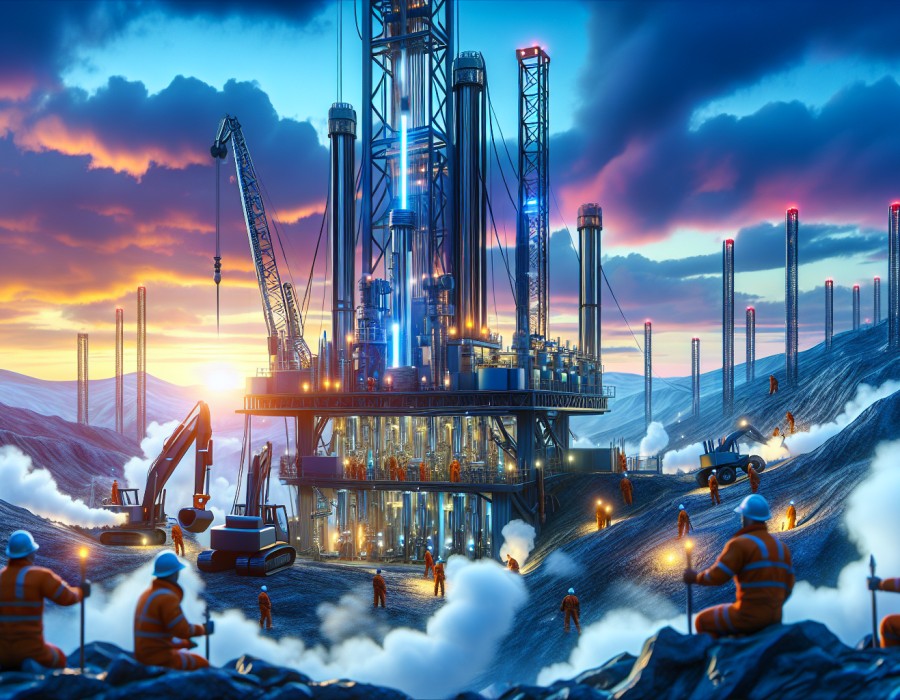Introduction to Well Drilling Rig Operations
Well drilling rig operations are complex and challenging, requiring skilled personnel and advanced equipment to ensure successful completion of projects. These operations involve drilling deep into the Earth's surface to access valuable resources such as oil, gas, and water. However, the process is not without its challenges, and operators must be prepared to navigate various issues that may arise during drilling operations.
Land Rigs
Land rigs are the most common type of well drilling rig, used for onshore drilling operations. These rigs are typically mounted on large trucks or trailers, making them relatively mobile and adaptable to various terrains. Land rigs are suitable for drilling oil, gas, and water wells in a wide range of depths and formations.
Offshore Rigs
Offshore rigs are designed for drilling operations in marine environments, such as oceans, seas, and lakes. These rigs are more complex and expensive than land rigs due to the challenges posed by the aquatic environment. Offshore rigs can be classified into several categories, including:
- Jack-up Rigs
- Semisubmersible Rigs
- Drillships
Each type of offshore rig has its own unique features and capabilities, suited for different water depths and drilling conditions.
Common Challenges in Well Drilling Rig Operations
Despite advances in technology and safety measures, well drilling rig operations face numerous challenges that can impact the efficiency, safety, and success of the project. Some of the most common issues include:
- Equipment Failure
- Formation Instability
- Stuck Pipe
- Lost Circulation
- Wellbore Instability
- Health and Safety Risks
Equipment Failure
Equipment failure is a significant challenge in well drilling rig operations. The harsh environment and constant use of drilling equipment can lead to wear and tear, resulting in breakdowns and malfunctions. Common equipment failures include:
- Drill Bit Damage
- Mud Pump Failure
- Top Drive Malfunction
- Electrical System Issues
To minimize the risk of equipment failure, regular maintenance and inspections are essential. Operators should also have contingency plans in place to quickly address and resolve any equipment issues that may arise during drilling operations.
Formation Instability
Formation instability is another common challenge faced in well drilling rig operations. As the drill bit penetrates deeper into the Earth's surface, it encounters various geological formations with different properties and behaviors. Some formations may be unstable, leading to problems such as:
- Hole Collapse
- Fluid Influx (Kick)
- Fluid Loss
- Fracturing
To mitigate the risks associated with formation instability, operators must have a thorough understanding of the geological conditions in the drilling area. This knowledge allows them to select the appropriate drilling techniques, mud properties, and casing designs to ensure wellbore stability and prevent formation-related issues.
Stuck Pipe
Stuck pipe is a situation where the drill string becomes immovable in the wellbore, either due to differential sticking or mechanical sticking. Differential sticking occurs when the drill string is pressed against the wellbore wall by a pressure differential, while mechanical sticking happens when the drill string becomes lodged in the wellbore due to obstacles or irregularities.
Stuck pipe can cause significant delays and increase the overall cost of the drilling operation. To prevent stuck pipe incidents, operators should:
- Maintain proper mud properties
- Control the rate of penetration
- Use appropriate drill string components
- Conduct regular hole cleaning
In the event of a stuck pipe, various techniques can be employed to free the drill string, such as:
- Jarring
- Washing Over
- Fishing
- Sidetracking
Lost Circulation
Lost circulation is a phenomenon where drilling fluid (mud) is lost to the formation instead of returning to the surface. This can occur when the mud pressure exceeds the formation fracture pressure, causing the fluid to escape into the formation. Lost circulation can lead to several problems, including:
- Wellbore Instability
- Reduced Hole Cleaning Efficiency
- Increased Risk of Stuck Pipe
- Difficulty in Maintaining Mud Properties
To combat lost circulation, operators can use various techniques and materials, such as:
- Lost Circulation Materials (LCM)
- Cement Plugs
- Wellbore Strengthening
- Managed Pressure Drilling (MPD)
Wellbore Instability
Wellbore instability is a common challenge in well drilling rig operations, particularly in complex geological formations. Instability can manifest in various forms, such as:
- Hole Collapse
- Tight Hole Conditions
- Wellbore Breakouts
- Induced Fractures
Wellbore instability can lead to several problems, including stuck pipe, lost circulation, and difficulty in running casing or completing the well. To maintain wellbore stability, operators must:
- Optimize Mud Properties
- Control the Rate of Penetration
- Use Appropriate Casing and Cementing Techniques
- Monitor Wellbore Conditions
In some cases, advanced drilling techniques, such as underbalanced drilling or managed pressure drilling, may be employed to mitigate wellbore instability risks.
Health and Safety Risks
Well drilling rig operations pose significant health and safety risks to personnel due to the hazardous nature of the work environment. Some common risks include:
- Hydrogen Sulfide (H2S) Exposure
- Fire and Explosion Hazards
- Working at Heights
- Heavy Equipment Handling
- Noise Exposure
To ensure the safety of personnel, operators must implement comprehensive health and safety programs, including:
- Hazard Identification and Risk Assessment
- Personal Protective Equipment (PPE)
- Emergency Response Plans
- Regular Safety Training and Drills
- Compliance with Industry Standards and Regulations
Conclusion
Well drilling rig operations are complex and challenging, requiring a deep understanding of the various issues that may arise during the drilling process. By being aware of common challenges such as equipment failure, formation instability, stuck pipe, lost circulation, wellbore instability, and health and safety risks, operators can take proactive measures to mitigate these issues and ensure the success of their drilling projects.
Continuous improvement in technology, processes, and personnel training is essential to navigate the ever-evolving challenges in well drilling rig operations. By staying up-to-date with industry best practices and investing in advanced drilling techniques and equipment, operators can enhance the efficiency, safety, and profitability of their well drilling rig operations.





Comments